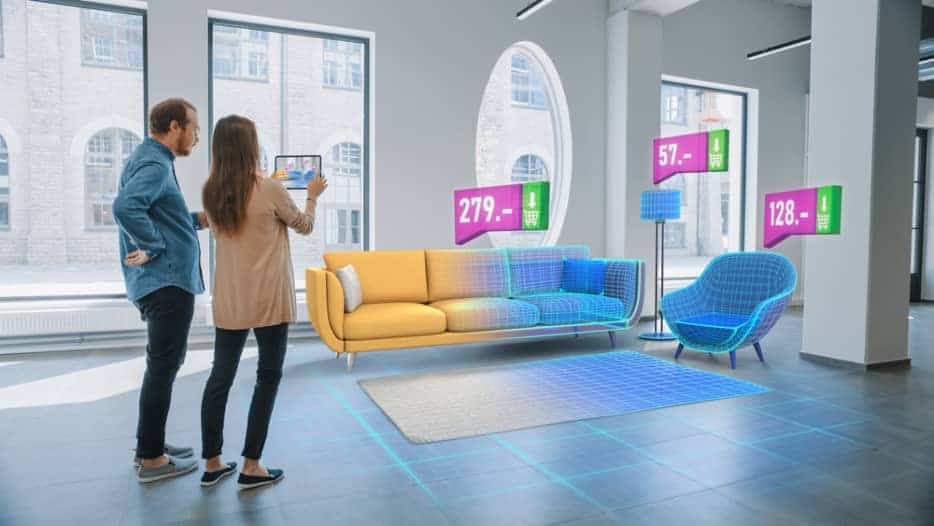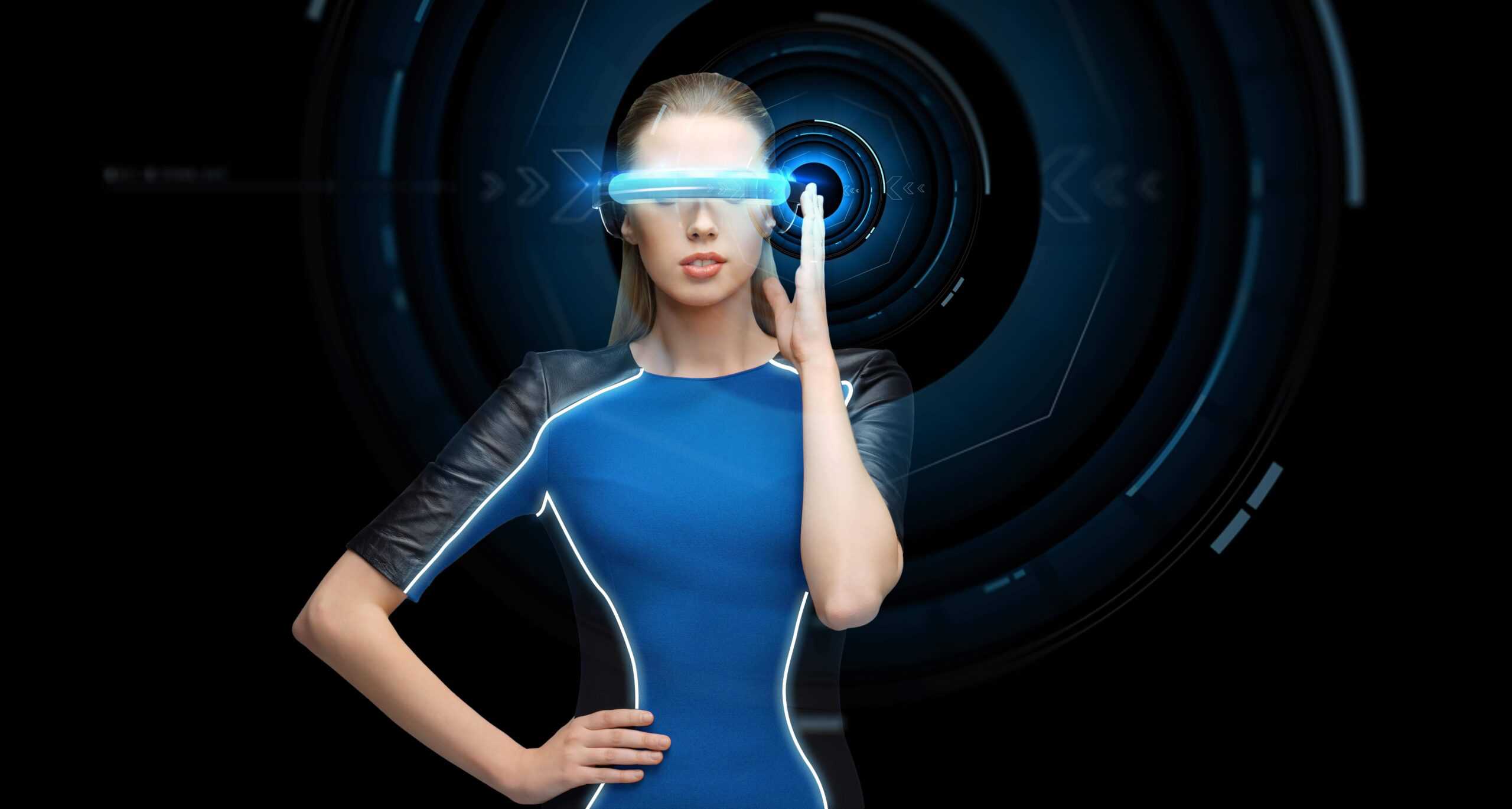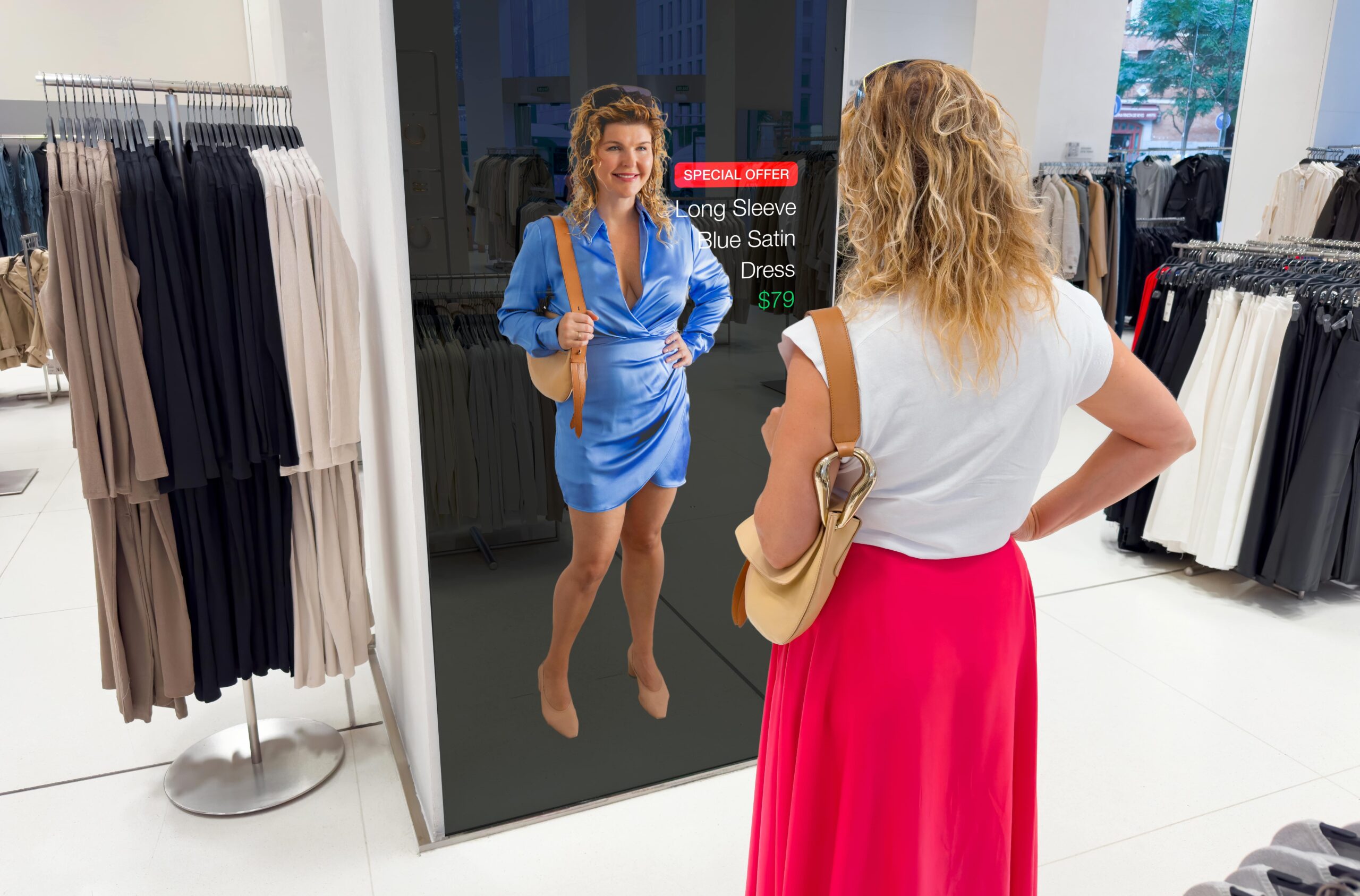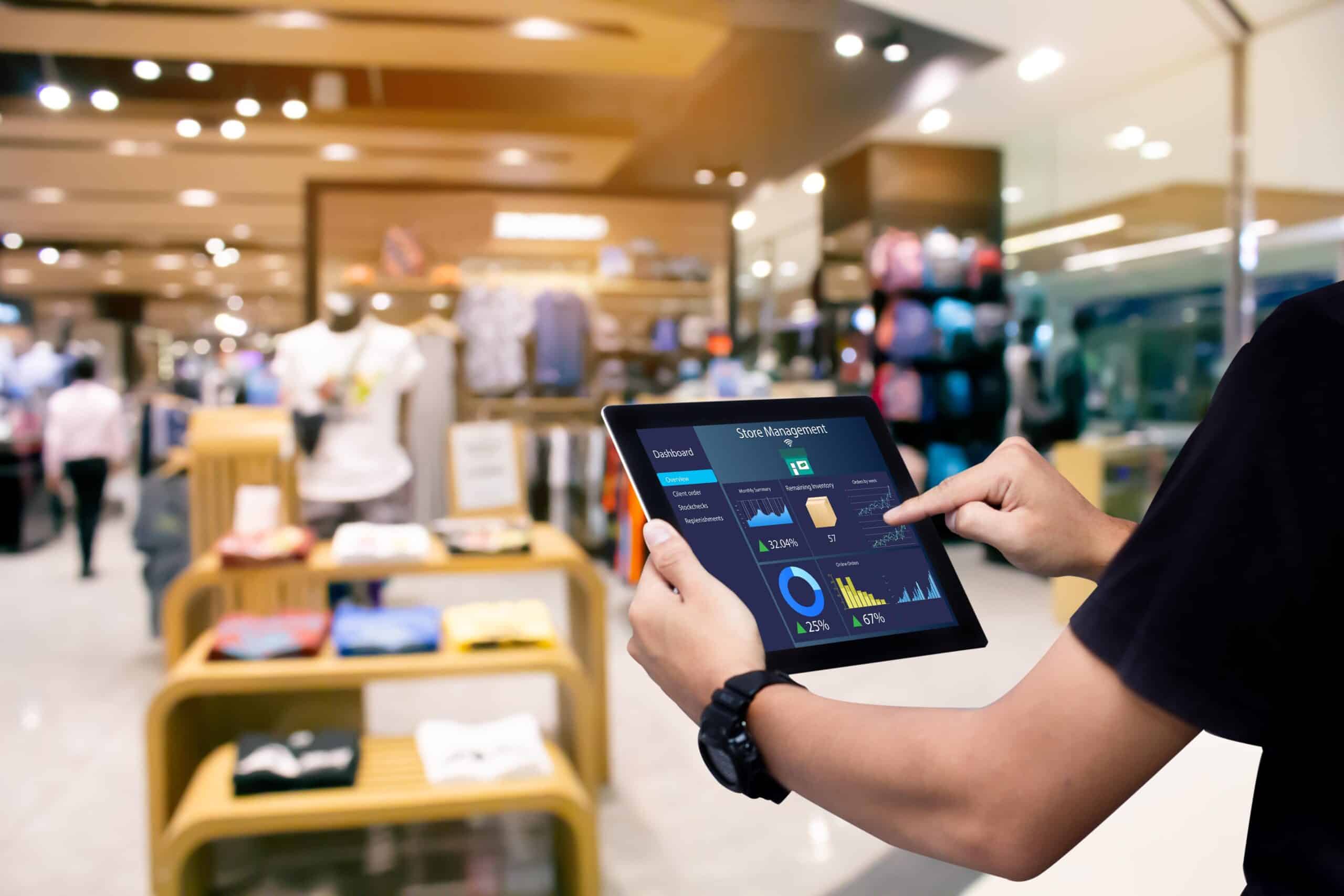- Overly and Tere Piim team up to create packaging with high entertainment value
- Furniture giant John Lewis adds ‘Virtual Sofa’ AR feature to its app
- If the shoe (or dress) fits, wear it! You can now try it on for size with AR
- Burberry uses AR to enhance the customer experience and transform production processes
- Amazon’s AR feature lets you view multiple furniture pieces in your own home
- Will augmented shopping become the norm?
In the future, we will no longer shop in high streets, or shopping malls, or page through paper product catalogues. Instead, we will increasingly browse and shop online – whether on our computers or smartphones – and select products based on our preferred style, colour and dimensions, assisted by augmented reality (AR). This technology enables you to try clothes or various other products or services, all from the comfort of your home. AR and 3D technology even allow you to choose the virtual environment you want to try these products out in. Since 2018, the number of mobile AR users has nearly doubled, and the popularity and use of this technology is predominantly driven through social media. According to Deloitte insights, “today, more than 1 billion smartphones and tablet devices can deliver augmented experiences.” And in their 2019 press release, research institute Gartner predicted that “100 million consumers will shop in augmented reality online and in-store by 2020.”
Retailers are well aware that the use of AR helps increase the perceived value of products and brands. It helps companies with visual storytelling and helps customers associate a certain brand with positive emotions. This, in turn, leads to improved sales and increased revenue. Virtual demonstration of product and service offerings also enhances brand awareness and customer satisfaction, leading to improved market growth. Let’s have a look at some of the incredible ways retailers are using AR.
Overly and Tere Piim team up to create packaging with high entertainment value
Emotional branding enables you to connect with your users and (prospective) customers and shape how your brand is perceived. This is done by provoking your audience’s emotions through content that appeals to people’s aspirations, ego, needs or emotional states. Emotional branding can be more than 50 per cent more effective than traditional targeted advertising, and augmented reality is an excellent tool with which to enhance those emotional branding efforts. For instance, during the run-up to the Eurovision Song Contest 2019, Estonian dairy producer Tere Piim and Overly teamed up to create very special, interactive packaging. By scanning Tere Piim’s milk cartons, customers could access exclusive content like 3D messages, and even view snippets of performances by 3D mini versions of their favourite Eurovision participants. More than 50,000 people used the AR app with many hundreds of them sharing their experiences on social media using specific hashtags. The promotion boosted engagement across various social media platforms and resulted in a wealth of user-generated content. This, in turn, created excellent traction for the brand and led to an increase in sales.
Furniture giant John Lewis adds ‘Virtual Sofa’ AR feature to its app
Another company who has experienced the benefits of AR is furniture giant John Lewis. The company has launched an augmented reality feature that will enable customers to see how armchairs and sofas will look in their homes before they decide to buy them. The ‘Virtual Sofa’ feature will initially include 123 of the furniture shop’s most popular sofas, with additional furniture pieces to be added in the future. When browsing for furniture items and tapping on ‘View in Your Room’, your smartphone camera opens and prompts you to scan your space for dimensions. After a 3D model is generated, you can make a selection from a range of furniture and see how the items would look in the spot you have in mind for it. John Lewis’ head of online product and customer experience, Sean O’Connor, says: “Buying a new sofa or armchair is a very considered purchase as it’s something we tend to have for a long time. From talking to our customers we know that many of them go through as many as 13 different stages before making their final choice of sofa; so we wanted to simplify this process for them. Customers can now browse styles on our website, test comfort in one of our shops, and check scale and colour in their home using the AR function in the app. We know this will not only save a lot of time but also offer peace of mind that their new sofa will look great in their home.”
If the shoe (or dress) fits, wear it! You can now try it on for size with AR
A growing number of people are shopping online, a trend that’s accelerated by the worldwide lockdown measures and brick-and-mortar store closures. And with the pandemic showing no signs of abating, retailers are relying more and more on technology like AR to help customers try on products, even if they are physically unable to set foot in a store. Augmented reality enables you to display products as a filter on top of what you see through your smartphone camera. You can try on a new shade of eye shadow, see what you look like in that gorgeous (virtual) dress and even try a new pair of shoes. Many retailers have started to make use of Snap shopping filters (Snap being the parent company of Snapchat). Snap is now also offering AR try-on experiences for luxury brands like Dior and Gucci.
With special AR filters, trying on shoes while shopping online is easy as pie. All you have to do is point your smartphone camera at your feet and shoes appear. You can turn your feet from side to side to see the shoes from all angles. Many AR companies have started to create apps solely for trying things on. An example is Wanna Kicks – an app by Belarus startup Wannaby for trying on sneakers. All you have to do is choose a pair of shoes from the list of 3D models, point your camera at your feet and, voila, you’re virtually wearing the sneakers. “Our mission is to break online shopping barriers,” says Wannaby CEO Sergey Arkhangelskiy. “We believe that AR try-on can help customers to shop online and will wash away the difference between online and offline shopping. We see two major problems in the shoe market. Online conversions are quite low, and returns are quite high, in comparison to traditional ‘brick-and-mortar’ shopping. The ability to try sneakers with your phone before buying online should shift conversions, engagement and returns.”
Burberry uses AR to improve the customer experience and transform production processes
Even luxury fashion brands are slowly but surely starting to embrace immersive technology as a new way of interacting with consumers and transforming their design- and production processes. At the start of 2020, Burberry launched a new AR tool to enable customers to experience AR versions of Burberry products embedded in their real-life environment against other objects. Think accessories like a virtual handbag worn with a real-life outfit. This helps simulate the in-store shopping experience and gives the customer a better feel for the product before buying it.
Burberry has also linked up with Koffeecup, a London-based digital production agency that specialises in immersive tech like VR, AR, and mixed reality. The partnership has enabled the fashion giant to develop an app that combines gaming tech and design “to significantly speed up and simplify the process of placing prints onto garments”. With the new software, a 2D print can be placed onto a 3D product template, which enables a more creative, efficient, and sustainable process, as you immediately see what the final product will look like. The app makes it possible to significantly reduce the use of paper at the design stage and to produce an accurate sample with fewer iterations, resulting in less cut factory waste, supporting Burberry’s sustainability goals. Thomas Michelou, MD at Koffeecup, says: “It has been a pleasure to work closely with Burberry to deliver this project and see first-hand how the print placement application has improved their creative process. At Koffeecup, we saw this as an opportunity to leverage technology that is usually used in gaming development and apply it to the luxury fashion space. This pioneering shift from gaming to design allowed us to move towards generating a real-time visual experience that resonated well with our creative audiences. We are very excited about the software’s potential for development. Looking to the future, we see the possibility to incorporate artificial and virtual reality to extend the software, which is a very interesting prospect.”
Amazon’s AR feature lets you view multiple furniture pieces in your own home
Retail giant Amazon is introducing its new AR Room Decorator shopping tool, that enables you to see virtual furniture and other home décor items in your own home. What makes Room Decorator different from Amazon’s previous AR tools is that this new one enables you to add multiple virtual items to a space at the same time. This way, it’s easier to visualise how an entire new interior would fit in your home, and enables you to design a whole room from your smartphone or desktop. Room Decorator also offers customers recommendations on complementary products that they can move around and view from various angles in their home to get a good idea of what they would look like. The feature can be used with thousands of furniture and décor items available on Amazon. The décor items are represented at scale and in high-definition, and the customer’s virtual room can also be saved for editing at a later stage. To get started, all you have to do is click the ‘View in Your Room’ button. “Amazon is always exploring new ways to create experiences that delight our customers. With the addition of Room Decorator tools, Amazon enhances its augmented reality feature to give customers an even more immersive shopping experience from the comfort of their own home, or on the go. With access to the inspiring furniture styles available on Amazon, customers can do more than just imagine their dream rooms – they can visualise them to make more informed shopping decisions,” says an Amazon spokesperson.
Will augmented shopping become the norm?
The market readiness for AR was already quite clear before the pandemic struck, with ongoing technology-led consumption trends resulting in customers increasingly embracing digital and contactless shopping. Social distancing measures, lockdowns, and other restrictions have, however, further accelerated these developments. In fact, according to a recent report by IBM, the pandemic has accelerated the shift to digital shopping by five years. Many retailers, both large and small, have started trialling AR to offer their customers enhanced shopping experiences and boost their revenues. Not only retail and furniture giants like Amazon and IKEA, but also luxury brands like Burberry, Gucci and Prada have jumped on the AR bandwagon, collaborating with a variety of partners, such as social media platform Snapchat and AR app developer Overly.
Although we’ve yet to experience the full potential of AR, this tech is already transforming the way we shop. And there’s no doubt that AR shopping will become the norm in the next five to ten years. “The coming years are going to be very important, as they will show us other layers of immersion in the world of AR. All that matters at this point is that everyone is aware of the importance of adapting to this technology,” writes Azad Abbasi for Forbes.




